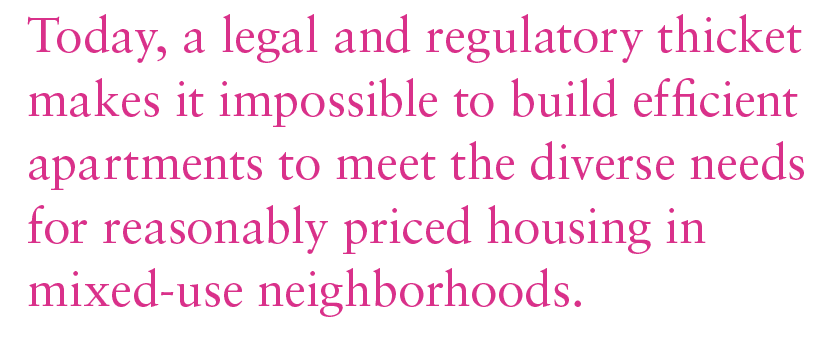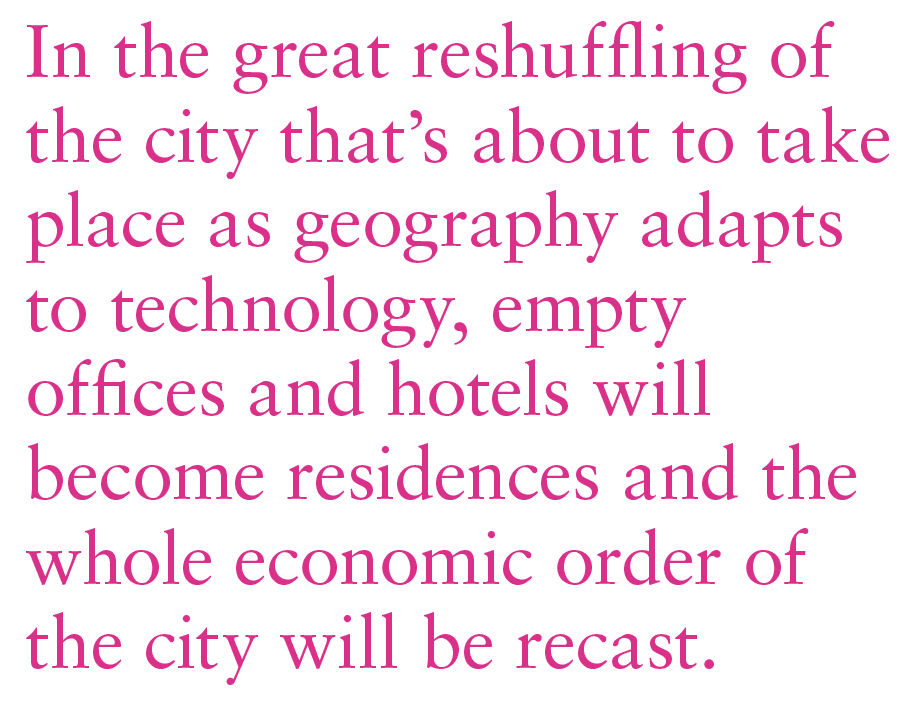(Note: This article has been adapted from Real Estate: A Love Story by Joshua Benaim, released June 2021. To learn more, visit realestatealovestory.com.)
Could an idea to “bring back” New York after the pandemic work in other cities?
There’s been a lively debate over whether cities are dead.[1],[2],[3] With the recovery gaining steam, it has become clear that rumors of the city’s demise have been greatly exaggerated. But there’s no question that cities are hurting badly. Before the coronavirus, many of our greatest cities got overheated and unaffordable and became unlivable for many people. Now, technological changes accelerated by COVID—principally remote work—pose a deeper challenge to the life of cities.
Yet cities have a unique and indispensable role to play in our society. They give people a place to discover their purpose, build their careers, and find love. If there is room for optimism amid this historic tragedy, it is that the current technological and social challenges will spur us to reimagine our great cities to deliver on the unbelievable potential of city life.
As the great cities of America begin to recover, we have an opportunity to rebuild them better. And as a prototypical global city in the US, New York provides a meaningful case for imagining the future.
REAL ESTATE: A LOVE STORY
I grew up on the West Side of Manhattan in the 1970’s and 1980’s. Pretzel vendors, yellow checker cabs, and feeding pigeons in Central Park were my daily fare. I lived in a neighborhood filled with fascinating people pursuing their dreams.
Many years ago, I was waiting for the M10 bus in the rain on my way home from school and shared a taxi with a lady with a stroller and a young child. Turns out she was heading to meet an opera teacher on my block. She said something about kismet, a Turkish loanword which she explained meant destiny or serendipity. Who would have imagined that after joining her at the lesson, I fell in love with opera, built a real estate company inspired by creativity and beauty, and even got to perform with the Metropolitan Opera in my old neighborhood? Only in New York!
But it’s hard to imagine all that happening today.
I see four key areas of investment and action that would help bring New York City and the great cities of America back better than before. These are a few ideas—not a comprehensive prescription for public policy or a panacea for the major challenges of jobs, health care, transit, inequality, climate change, and quality of life. Perhaps they will constitute a tiny piece of the puzzle of how to make a more just and beautiful city
EMBRACE HOUSING BIODIVERSITY
We need to address affordability and create mixed-income, mixed-use, intergenerational neighborhoods. Developers today have really two choices—build expensive, Class A apartments, or build federally subsidized low-income housing. There’s no in between. This makes for a tale of two cities. Housing monoculture—whether for rich or poor—isn’t good for anyone.
This can be addressed by embracing what I call housing biodiversity. We need a mixture of family apartments, small units for young single people, affordable housing, co-living, rooming houses, middle-income apartments, and senior living. A mixture of incomes and generations living together in the same buildings, in the same neighborhoods. That’s what made the West Side great.

Regulations that have accumulated over generations still shape what can and cannot be built. The result is less density and significantly less supply of housing. New York City is a prime example. “The 1910 population of Manhattan was 2,331,542, or 164 people per acre. In 2010, the population was 1,585,873, or 109 people per acre.”[4] How is it that we accommodated one million more people one hundred years ago on the same island?
As we emerge from COVID, we have a fresh chance to re-examine zoning laws to allow the kinds of walkable, mixed-use neighborhoods and housing housing we need. Why not make it legal to creatively live in small spaces? Why maintain zoning districts that keep work and life apart? Why regulate what light and air constitutes a bedroom, where across the country people are getting creative about sleeping quarters? Code-compliant new apartments are so great that no one can afford to live in them.
Allowing people to revive hotels as apartments without kitchens would make more affordable units and provide much needed work to restaurant workers, who could reactivate the hotel restaurant and bar. At present, a costly renovation would be required to obtain a residential Certificate of Occupancy. There are a lot of concerns about young newcomers moving into established neighborhoods and raising the rents. Accommodating more young professionals in converted hotels or newly constructed smaller units would relieve some of the pressure on the remainder of the housing stock and stands to make housing more attainable for everyone.
With beautiful, mixed-use, mixed-income neighborhoods, more people could walk to work. While the virus has wreaked havoc on our aging public transportation infrastructure, which needs long-term investment and support, embracing housing biodiversity and adaptive reuse would be an immediate shot in the arm. And in an era of climate change, less commuting would be a win for quality of life and for the environment.
LET THE MUSIC PLAY ON
We need to invest in music and the performing arts to restore the vibrancy of the city. Cities need the arts and artists to provide the creative energy, the innovation, and the fresh way of looking at the world that enriches our lives and supports the growth of media and creative industries.[5] Recent legislative efforts have helped arts venues stay afloat, but the ecosystem of performing artists is in dire straits. Why are large industries bailed out, but artists and musicians left for dead? These are the people who make us laugh or cry and feel human.
Once we safely reopen, we must ask ourselves how we can create an ecosystem of artist housing, so people have a place to live that’s reasonably priced. Many of the artists, costume makers, set designers, lighting designers, orchestral musicians, dancers, and singers have had to leave New York City because it’s unaffordable, and COVID has accelerated that shift. These are economic and artistic ecosystems (clusters, to borrow the language of HBS professor Michael Porter) that have been created and sustained over generations. Think about how it feels to walk through the streets of New York and hear a solo saxophone playing “My Funny Valentine,” or to experience “Hamilton” or to hear “La Bohème” for the first time. Let’s invest in safe concerts and in safely reopening performing arts venues. Let’s invest in affordable artist housing to make New York and other great cities hospitable to the artists who bring our city to life. Without music, the city is dead.
MORE STREETS FOR MORE PEOPLE
We need a new era of creative urban design and parks to encourage walking, nurture neighborhoods, and democratize city living. Central Park was created as a great democratic experiment, a natural place as grand as any English manor, but free for all to enter and find refuge in the heart of the city. There are no elaborate gates. The creators of the park wanted anyone to walk in and feel at home.

We have seen what happens when restaurants spread out as outdoor cafes—the city blossoms with street life. What if that’s just the beginning? A recent article in the New York Times by Farhad Manjoo highlighted city streets as a vast land area ripe with opportunity for reinvention.[6] According to the article, roughly one quarter of New York City land area is taken up by roads, parking, and places for cars. “The island of Manhattan is about 23 square miles. Much of it is covered in roadway, street parking and parking garages. If you added up all the space Manhattan devotes to cars, you’d have an area nearly four times as large as Central Park.” Consider the potential for city life if some of that area were reclaimed for people!
As a thought experiment, imagine if large chunks of Broadway became a walking park, flanked by outdoor cafes and theaters? An unconventional path that has always marched to the beat of its own drummer, Broadway winds its way from the bottom to the top of Manhattan and beyond. With all the bike trails and pedestrian plazas installed with great effect during the Bloomberg administration under the leadership of Janette Sadik-Khan, much of it barely serves for vehicular traffic anymore.[7] Pedestrian friendly zones are great for retail. In cooperation with local merchants, Broadway theaters, and restaurateurs, there’s so much potential to reimagine the streetscape.[8] With the epic success of the High Line, why not figure out how to make one on the ground?
Great cities have beautiful walks. Romantic walks. Business walks. I know businesspeople who do their meetings on walks so they don’t sit on a desk all day! People who walk live longer. Let’s restore broad swathes of the city to shoe leather. It will make the city much more livable.
Paris is leading the way in the reinvention of public streets and plazas. Under the leadership of Mayor Anne Hidalgo, Paris is embracing the concept of “the fifteen-minute city” expounded by Carlos Moreno, a professor and visionary of urbanism. “His fifteen-minute concept was developed primarily to reduce urban carbon emissions, reimagining our towns not as divided into discrete zones f or living, working, and entertainment, but as mosaics of neighborhoods in which almost all residents’ needs can be met within 15 minutes of their homes on foot, by bike, or on public transit.”[9] The thinking is that as people start to live and work in closer proximity, street space that is presently used for cars can be reimagined for other uses.
In the great reshuffling of the city that’s about to take place as geography adapts to technology, empty offices and hotels will become residences and the whole economic order of the city will be recast. If people can live and work in the same neighborhood, so much the better. Let’s try to do it to enhance the neighborhood as the unit of organization. That’s what makes New York so terrific. Ultimately, we need a broad movement of property ownership, civic leaders, business owners, and citizens to capitalize on the enormous opportunity of reimagining public space for people.
BUILD THE NEXT GENERATION OF BUILDERS
We need a new form of inclusive business education, to embrace all of our society. Business, industry, creativity, and technology will need to be part of the solution. We need a way to bring in the talent that exists and teach young people how to use their talents in a meaningful way. That business can be a force for good and can make a difference in people’s lives. I have built many luxury homes, and those are a lot of fun, but the most meaningful work has been making creative use of unappreciated and misunderstood raw materials and turning them into places for people to live a big life in the city at a lower cost.
There is already a movement afoot to do this. Project Destined, a nonprofit organization that transforms minority youth into owners and stakeholders in the communities in which they live, is bringing diverse high schoolers and college students and veterans who might never have had the chance to learn the real estate business into the fold. For example, I had a chance to work with a group of interns from Howard University last Fall, which culminated in an exciting live business plan competition. The level of passion for real estate and thoughtful preparation was inspiring—and bodes well for the future of our industry. We who are part of development, construction, and fi nance help shape and build the city. We need to ask ourselves what kind of a city do we want to build?
We know in our hearts what it will take to get New York and other great cities back. It will take patience. It will take love. It will take a lot of work—private sector, philanthropic, thought leadership, government. This is a hard time, but also a time of renewal and hope. By taking a small step to make our cities better and more livable, you never know if you might be opening the door to the next person pursuing their dreams.
THE HOUSING SECTION
ALSO IN THIS ISSUE (SUMMER 2021)
NOTE FROM THE EDITOR / The Housing Issue
AFIRE | Benjamin van Loon
INVESTOR SENTIMENT / Shining Through Darkness
The 2021 AFIRE International Investor Survey underscores a sense of calculated optimism for CRE investment in the year ahead.
AFIRE | Gunnar Branson
ECONOMY / Revisiting Inflation
For commercial real estate investors, inflation fears are real— but are they rational?
Aegon Asset Management | Martha Peyton, PhD
DEURBANIZATION / Herd Community
Uncertainty surrounding remote work and politics suggest a wide range of potential outcomes for big cities, which may upend the long-running megatrend toward urbanization.
Green Street | Dave Bragg and Jared Giles
HOUSING / How to Rebuild
Could an idea to “bring back” New York after the pandemic work in other cities?
Aria | Joshua Benaim
HOUSING / Single Family, Multiple Questions
Institutional ownership in single-family rentals accounts for less than 5% of the segment, but answers to key questions could change start to change that balance.
Berkshire Residential Investments | Gleb Nechayev, CRE
HOUSING / Institutionalizing Single Family
Over the past two decades, the single-family rental industry has evolved into an institutional-caliber asset class—so where is the sector going next?
Tricon Residential | Jonathan Ellenzweig
HOUSING / Build-to-Rent Boom
The future is bright for build-to-rent and institutional investors are increasingly looking at investing in this sector.
Squire Patton Boggs | John Thomas and Stacy Krumin
OFFICE / Recovering the Office
While most agree that the office sector has a difficult road ahead, there is less consensus about future demand in the sector. What are the indicators investors should be tracking?
Barings Real Estate | Phillip Conner and Ryan Ma
OFFICE / London Calling
With Brexit and pandemic resolutions coming into focus, pricing disparities could dissipate based on improved cross-border liquidity and cap rate compression in the London office market.
Madison International Realty | Christopher Muoio
LOGISTICS / Supply Change
Urbanization, digitalization, and demographics are the key trends to watch for understanding the future of logistics real estate.
Prologis | Melinda McLaughlin and Heather Belfor
CLIMATE / Accounting for Environmental Risk
When it comes to guards against environmental risk, Boston, Indianapolis, Minneapolis, and Portland are some of the most prepared US cities. What makes them different?
Yardi Matrix | Paul Fiorilla, Claire Anhalt, and Maddie Harper
ESG / Putting People First
Though “impact investing” is no longer totally distinct from investing in general, investors still have a lot of work to do for fulfilling the social and governance aspects of ESG expectations.
Grosvenor Americas | Lauren Krause and Brian Biggs
MULTIFAMILY / Influencing Multifamily
As we come out of the pandemic to a new economy, it seems likely that the creator economy will continue to grow. This will have a major impact on the multifamily sector.
citizenM Hotels | Ernest Lee
TALENT / Enhancing Life Sciences
As the global life sciences sector continues to grow in real estate, highly specialized skills and experience will be the keys to success.
Sheffield Haworth | Max Shepherd and Jannah Babasa
EDUCATION / Real Estate Education Goes Global
The evolution of global real estate education over the past three decades will be integral to developing a rich pipeline of talent for the future of commercial real estate.
Georgetown University | Julian Josephs, FRICS
—
ABOUT THE AUTHOR
Joshua Benaim is the Founder of Aria, an award-winning real estate company, an operatic baritone, and the author of Real Estate, A Love Story: Wisdom, Honor, and Beauty in the Toughest Business in the World.
—
NOTES
1. Altucher, James. 2020. “New York City is dead forever: here’s why.” NYPOST.com. August 17, 2020. nypost.com/2020/08/17/nyc-is-dead-forever-heres-why-james-altucher/
2. Seinfield, Jerry. 2020. “So you Think New York is ‘Dead.’ It’s Not.” NYT.com. August 24, 2020.
brooklynvegan.com/jerry-seinfeld-responds-to-nyc-is-dead-forever-article-i-will-never-abandon-new-york-city-ever/
3. Saunders, Pete. 2021. “Remote Work Won’t Kill New York.” Bloomberg.com. May 28, 2021.
bloomberg.com/opinion/articles/2021-05-28/covid-19-won-t-destroy-appeal-of-cities-like-new-york
4. Dunlap, David W. 2016. “Zoning Arrived 100 Years Ago. It Changed New York City Forever.” NYT.com. July 25, 2016. nytimes.com/2016/07/26/nyregion/new-yorks-first-zoning-resolution-which-brought-order-to-a-chaotic-building-boom-turns-100.html
5. Seinfield, Jerry. 2020. “So you Think New York is ‘Dead.’ It’s Not.” NYT.com. August 24, 2020.
brooklynvegan.com/jerry-seinfeld-responds-to-nyc-is-dead-forever-article-i-will-never-abandon-new-york-city-ever/
6. Manjoo, Farhad. 2020. “I’ve Seen a Future Without Cars, and it’s Amazing.” NYT.com. July 9, 2020. nytimes.com/2020/07/09/opinion/sunday/ban-cars-manhattan-cities.html
7. Crowley, Michael. 2009. “Honk, Honk, Aaah.” Nymag.com. May 15, 2009. nymag.com/news/features/56794/
8. Chen, Yunyue and Jonathan Cohn. 2018. “Rethinking Manhattan’s Grid.” Bloomberg CityLab. August 30, 2018. bloomberg.com/news/articles/2018-08-30/how-manhattan-s-streets-would-look-as-valued-public-space
9. Bliss, Laura and Feargus O’Sullivan. 2020. “The 15-Minute City—No Cars Required—Is Urban Planning’s New Utopia.” Bloomberg.com. November 12, 2020. bloomberg.com/news/features/2020-11-12/paris-s-15-minute-city-could-be-coming-to-an-urban-area-near-you






